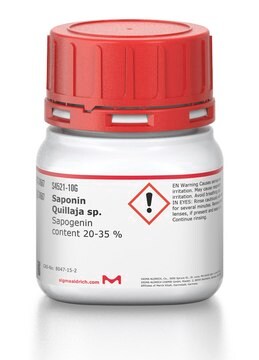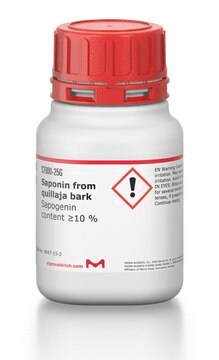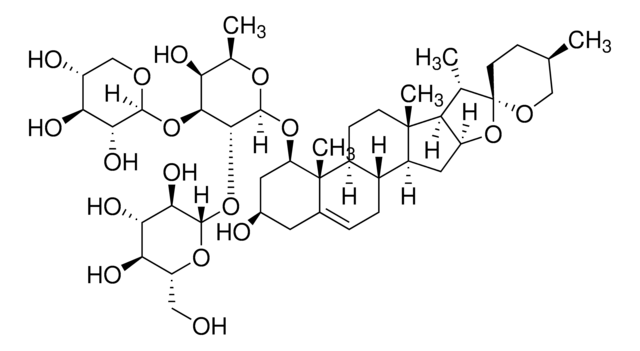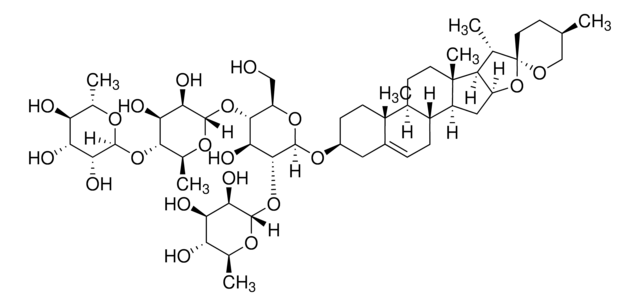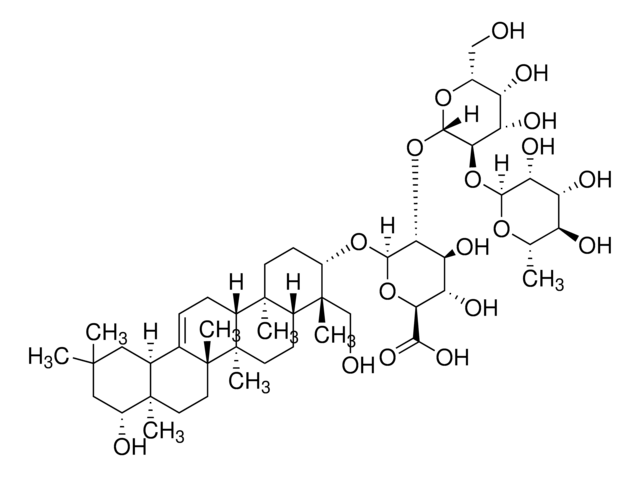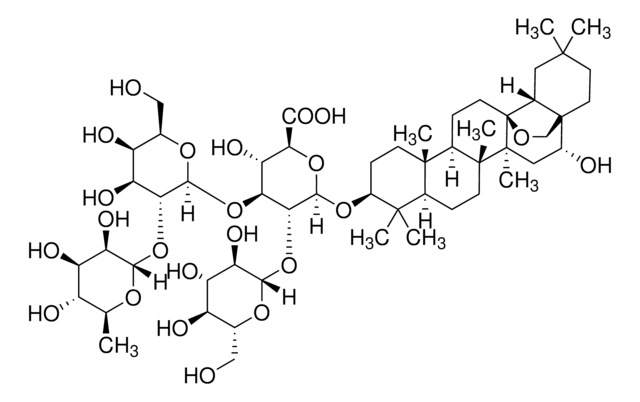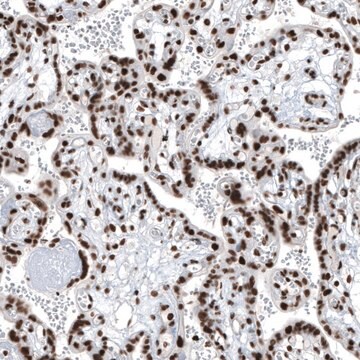84510
Saponin
used as non-ionic surfactant
Sinónimos:
glycosides, saponins
About This Item
Productos recomendados
biological source
plant (Quillaya)
form
powder
composition
Sapogenin, 8-25%
greener alternative product characteristics
Less Hazardous Chemical Syntheses
Use of Renewable Feedstocks
Learn more about the Principles of Green Chemistry.
sustainability
Greener Alternative Product
technique(s)
HPLC: suitable
protein quantification: suitable
impurities
≤20% sulphated ash
CMC
0.001-0.01%
solubility
water: 1 g/10 mL, clear to hazy, yellow to brown
density
1.015-1.020 g/mL at 20 °C (5% in H2O)(lit.)
greener alternative category
SMILES string
C[C@]1(CCC23COC4([C@H]2C1)CC[C@@H]5[C@]6(CC[C@@H](C(C6CC[C@]5([C@@]4(C[C@H]3O)C)C)(C)C)O[C@H]7[C@@H]([C@H]([C@H](CO7)O[C@H]8[C@@H]([C@H]([C@@H](CO8)O)O)O)O[C@@H]9[C@@H]([C@H]([C@@H]([C@H](O9)CO)O)O)O)O[C@H]1[C@@H]([C@H]([C@@H]([C@H](O1)CO)O)O)O[C@@H]1[C@@H]([C@H]([C@@H]([C@H](O1)CO)O)O)O)C)C=O
InChI
1S/C58H94O27/c1-52(2)29-7-11-55(5)30(8-12-58-31-15-53(3,22-62)13-14-57(31,23-77-58)32(64)16-56(55,58)6)54(29,4)10-9-33(52)82-50-46(85-51-45(40(71)37(68)27(19-61)80-51)84-49-43(74)39(70)36(67)26(18-60)79-49)44(83-48-42(73)38(69)35(66)25(17-59)78-48)28(21-76-50)81-47-41(72)34(65)24(63)20-75-47/h22,24-51,59-61,63-74H,7-21,23H2,1-6H3/t24-,25-,26-,27-,28+,29?,30-,31+,32-,33+,34+,35-,36-,37-,38+,39+,40+,41-,42-,43-,44+,45-,46-,47+,48-,49-,50+,51+,53-,54+,55-,56+,57?,58?/m1/s1
InChI key
MAEBCGDGGATMSC-OSHGGGOQSA-N
¿Está buscando productos similares? Visita Guía de comparación de productos
General description
Beyond their structural uniqueness, saponins play essential roles in biochemical processes, acting as secondary metabolites that facilitate protein penetration through cell membranes. Studies indicate their amphipathic nature and potential as hemolytic agents, contributing to their utility in immunoassays by stimulating the Th1 immune response and cytotoxic T-lymphocyte production. In cell biology, saponins find applications as nonionic surfactants, influencing cellular processes and interactions.
Moreover, saponins serve as promising components in vaccine research, functioning as adjuvants that can activate the mammalian immune system. This property, combined with their ability to solubilize low-density lipoproteins and regulate cholesterol concentration in micelles, makes saponins versatile and valuable in multidisciplinary research areas, including biochemical and cell biology research.
Application
- as a wetting agent to study its effects on the floatability of six plastics
- to permeabilize washed neutrophils for immunofluorescence
- as a supplement in phosphate buffer saline (PBS) for immunocytochemistry
Biochem/physiol Actions
Features and Benefits
- Suitable for Biochemical and Cell Biology research
- Can be used with HPLC and Protein Quantification
- High purity product for research applications
Other Notes
signalword
Warning
hcodes
Hazard Classifications
Eye Irrit. 2 - STOT SE 3
target_organs
Respiratory system
Storage Class
11 - Combustible Solids
wgk_germany
WGK 2
flash_point_f
Not applicable
flash_point_c
Not applicable
ppe
dust mask type N95 (US), Eyeshields, Gloves
Certificados de análisis (COA)
Busque Certificados de análisis (COA) introduciendo el número de lote del producto. Los números de lote se encuentran en la etiqueta del producto después de las palabras «Lot» o «Batch»
¿Ya tiene este producto?
Encuentre la documentación para los productos que ha comprado recientemente en la Biblioteca de documentos.
Los clientes también vieron
Nuestro equipo de científicos tiene experiencia en todas las áreas de investigación: Ciencias de la vida, Ciencia de los materiales, Síntesis química, Cromatografía, Analítica y muchas otras.
Póngase en contacto con el Servicio técnico
